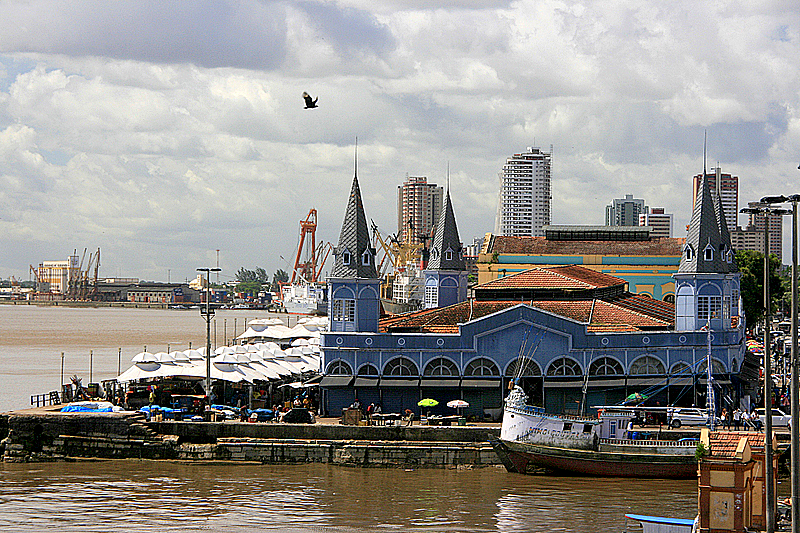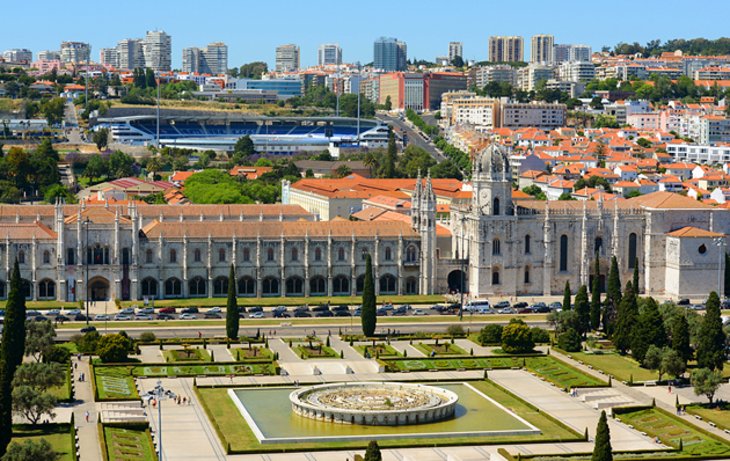Belém
Federal State
Palácio Antônio Lemos Praça Dom Pedro II, s / n
Belém is a city in northern Brazil; it lies at the Baía de Guajará, the mouth of the Rio Guamá in the Rio Pará and the Bay of Marajó. Belém is the capital of the state of Pará. The Greater Belém Belém with the districts ( 2006: about 1.4 million inhabitants) and the seamlessly adjoining districts Ananindeua and Marituba is the most populous metropolitan area of Pará and has about 2.3 million inhabitants. Belém is, next to Manaus, the main city of the Brazilian Amazon. The tree of mango trees streets of downtown Belém owes the nickname " the Mangueiras cidade " (city of mango trees).
History
The area of Belém originally belonged to the field of Tupinambás Indians.
Belém was founded on 12 January 1616 by the Portuguese captain Francisco Caldeira Castelo Branco. It was founded by the construction of the fortress Forte do Presépio (now known as the Forte do Castelo ) with the aim to defend the region against conquest attempts by the British, French and Dutch.
The city was first named Feliz Lusitânia. Then she was given the name of Santa Maria do Grão Pará and Santa Maria de Belém do Grão Pará until it has received its present name Belém.
Away from the rest of the country and strongly associated with Portugal Belém has recognized the Brazilian independence in August 1823 almost a year after its declaration.
Between 1835 and 1840, Belém was the scene of the uprising Revolta dos Cabanos, also known as Cabanagem. This uprising is regarded as one with the most authentic participation of the people in the country's history.
Due to the rubber boom Belém became the late 19th and early 20th century, of great economic importance. From this time magnificent buildings such as the Teatro da Paz originate (1878), Palácio Antônio Lemos, Palácio Lauro Sodré, Colégio Gentil Bitencourt and the Ver-o - Peso ( 1901).
Culture and sights
Although Belém is a little off the usual tourist routes, some interesting buildings and facilities are to visit:
Theater
Teatro da Paz, on the Praça da República. Built at the time of the rubber boom, resulting from the many of the historic buildings in the city. The theater was renovated in 2001 and is now back in operation.
Museums and Parks
Important museums are:
- Museu de Arte Sacra ( Sacred Art ) with the former Jesuit church of São Alexandro
- Museu do Estado ( changing exhibitions of contemporary artists)
- Museu das Onze Janelas ( Brazilian artists of the 20th century )
- Museu Emilio Goeldi Paraense ( park with Amazonian animal and plant species, anthropological and natural history exhibition, aquarium with Amazonian fauna)
- Bosque Rodrigues Álvez ( park with aquarium and animal enclosures )
Other buildings, markets and investments
- Ver-o - Peso: fish and vegetable market. Well worth a visit, especially early in the morning when the boats are unloaded. At the fish market, the diversity can be admired Amazonian fish species elsewhere are stalls with herbs natural remedies to which magical properties are attributed in part.
- The Fish Market building on the Ver-o - Peso ( "Look at the weight " ) is an iron structure, which was designed by Henrique la Roque and built in 1901.
- Forte do Presépio: Fortress of Belém, with an archeological museum
- Catedral da Sé: old cathedral of Belém
- Palácio Antônio Lemos
- Palácio Lauro Sodré
- Residência dos Governor's: former governor's palace with a small park, restaurant and Orchidarium
- Colégio Gentil Bitencourt
- Estação the Docas: former port facilities with restaurants and shops
- Presidio / Polo joalheiro: newly established jewelers and crafts center in a former prison.
- Engenho Murucutu: Ruins of sugar cane processing plant of the 18th century
- In Icoaraci district, small ceramics factories have moved to the makers of replicas of excavated on Marajó Marajoara discoveries
Regular events
The Círio ( de Nossa Senhora ) de Nazaré (since 1790), held each year on the second weekend of October, is the biggest festival of the city and is considered the largest religious festival in Brazil: Up to two million people come to the city and carry a statue of Mary in a litter is secured through the streets, because an approximately 400 meter long strong rope. Who can access the regular hard -fought rope ( " pegar a corda " ), but gets the belief awarded by the sins; this practice has already led to serious accidents. The procession shipped the statue of Mary and accompanies them in decorated boats on the bay provided superior. Children are small on this day painted boats and animal figures given from the light wood of the petioles of the Buriti palm, why flock to Círio also throngs of traders from the surrounding area with self- finished buildings, toys in the city.
Specialty
The kitchen of the Belém region is rich in Native American influences. Typical dishes are:
- Maniçoba: Finely chopped green leaves of the cassava plant with fatty meats and sausages (reminiscent of kale dishes ); is boiled for several days ( traditionally a week! ) to decompose the hydrogen cyanide contained in the leaves
- Pato no Tucupi: Duck and Jambu vegetables, cooked in Tucupi
- Tacacá: broth from Tucupi, with salted shrimp, Jambu and Goma ( mulled into a jelly- like mass cassava starch ),
- Açaí ( pulp and juice of the berries of the Acai Euterpe oleracea ) is served inter alia as a dessert
Serve with toasted manioc flour is ( grated cassava root; farinha, seared and seasoned: farofa ) ubiquitous, to be rice, black beans and various cold sauces with coriander leaves ( cheiro verde ), chopped tomatoes and onions or with hot peppers and other sharp berries ( pimenta ) served. For dessert, we recommend the sweet creams with pulp of bacuri ( Platonia insignis, Clusiaceae ) and cupuaçu ( Theobroma grandiflorum, Malvaceae ).
Sons and daughters of the town
- João Amazonas (1912-2002), Marxist theorist, politician and guerrilla
- Hélio Gracie (1913-2009), martial artist
- Aluísio Napoleão de Freitas Rego (1914-2006), diplomat and writer
- Carlos de Oliveira (1921-1981), Portuguese writer
- Benedito Nunes (1929-2011), philosopher, art critic, author and university professor
- João Clemente Baena Soares ( born 1931 ), diplomat
- Lucio Flavio Pinto ( born 1949 ), journalist and sociologist
- Sócrates (1954-2011), football player, doctor and political activist
- Fafá de Belém ( born 1956 ), singer
- Giovanni Silva de Oliveira (born 1972 ), football player
- Fumaça (born 1976 ), football player
- Caroline Ribeiro ( b. 1979 ) Model
- Paulo Henrique Chagas de Lima ( * 1989), football player
Archdiocese of Belém do Pará
- Archdiocese of Belém do Pará









